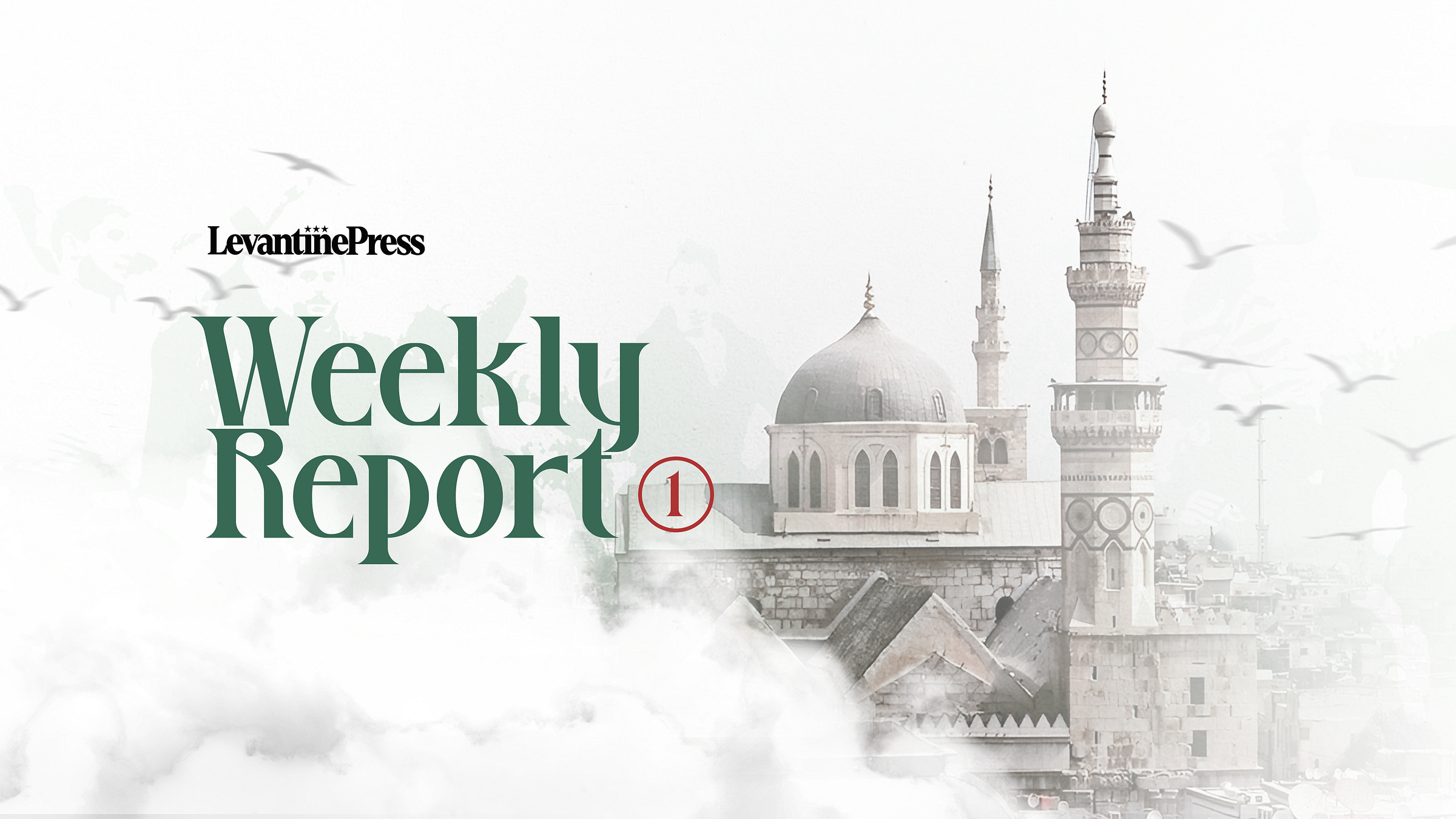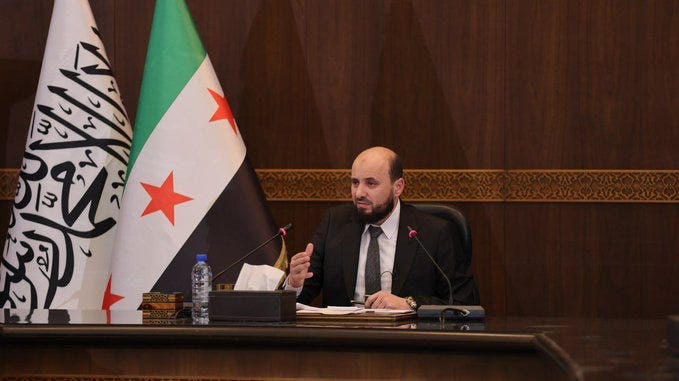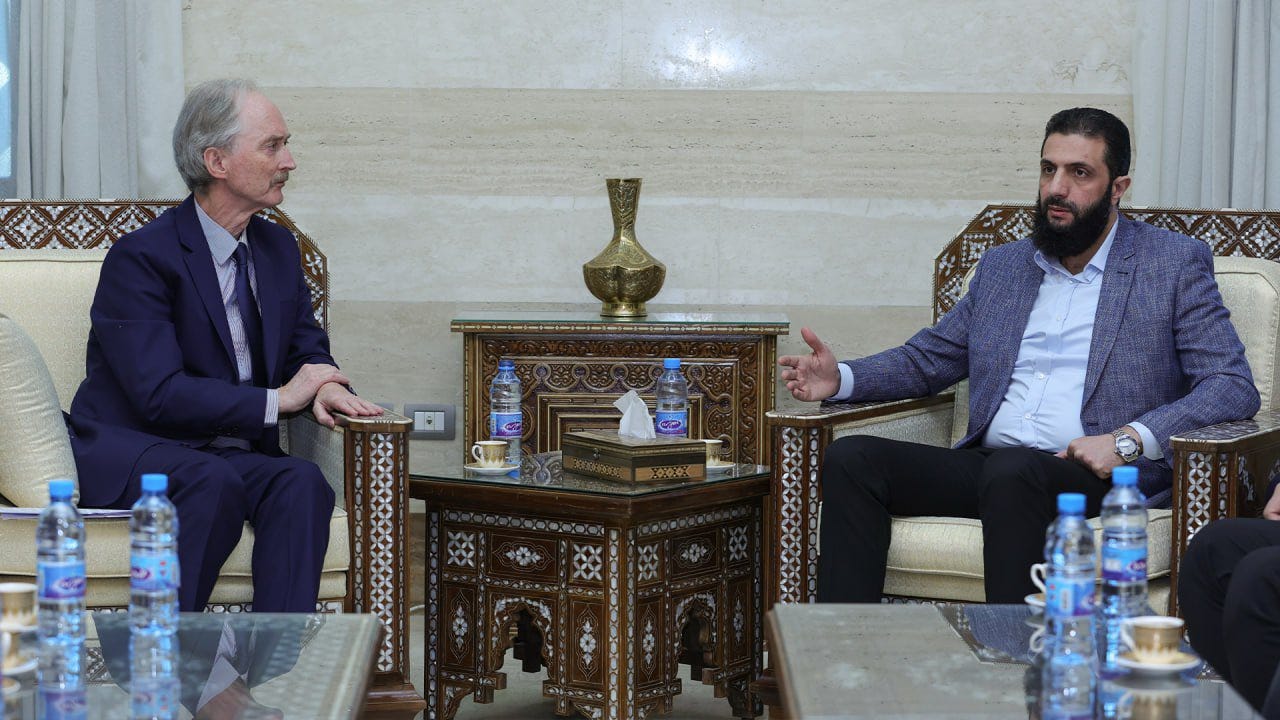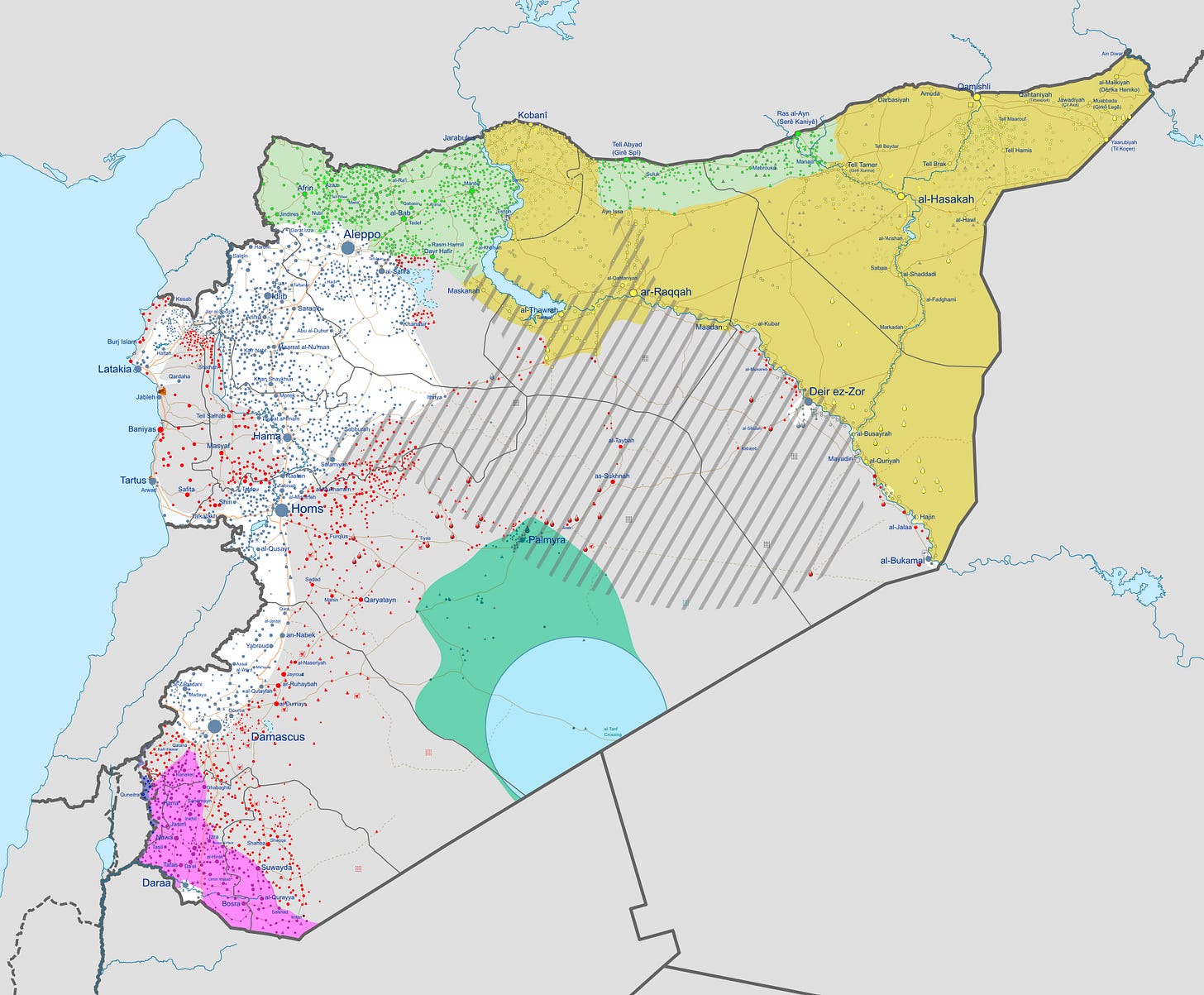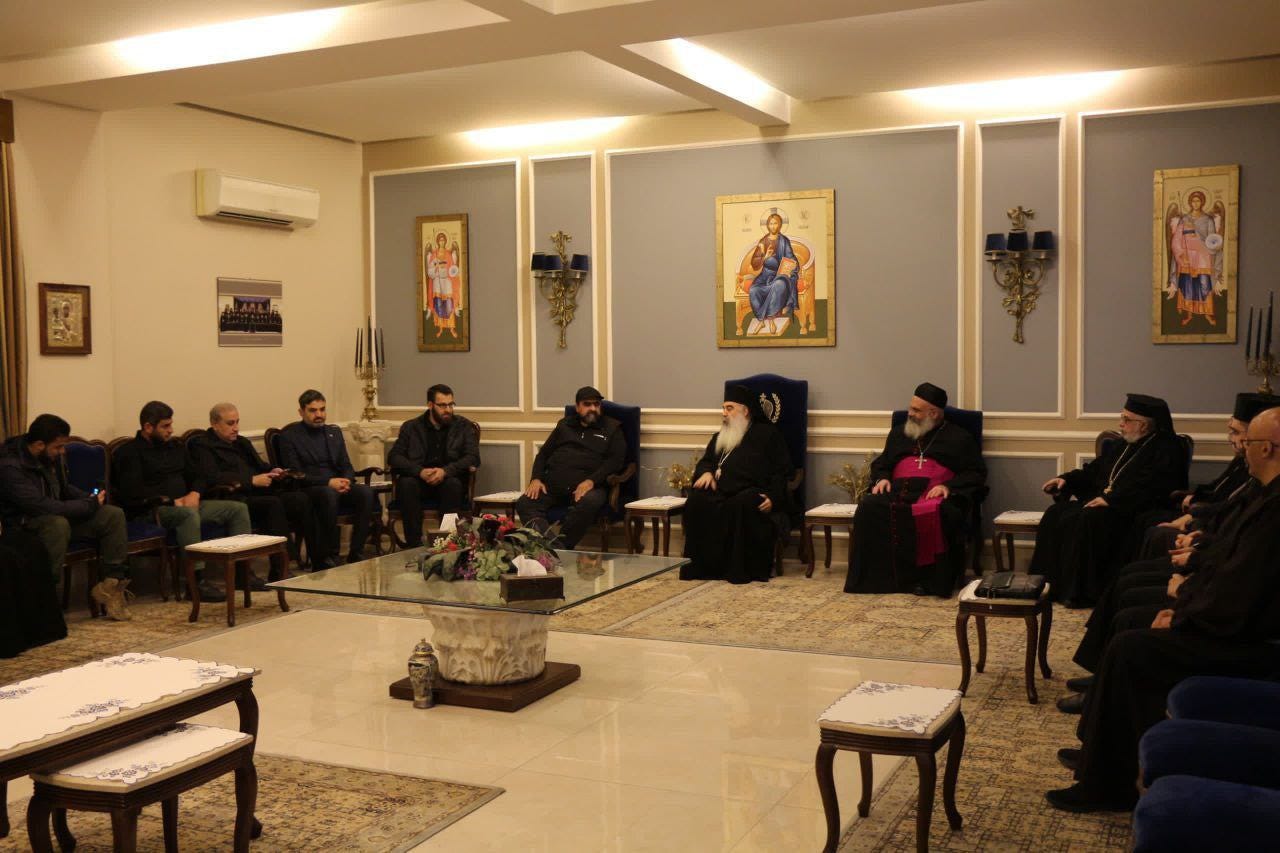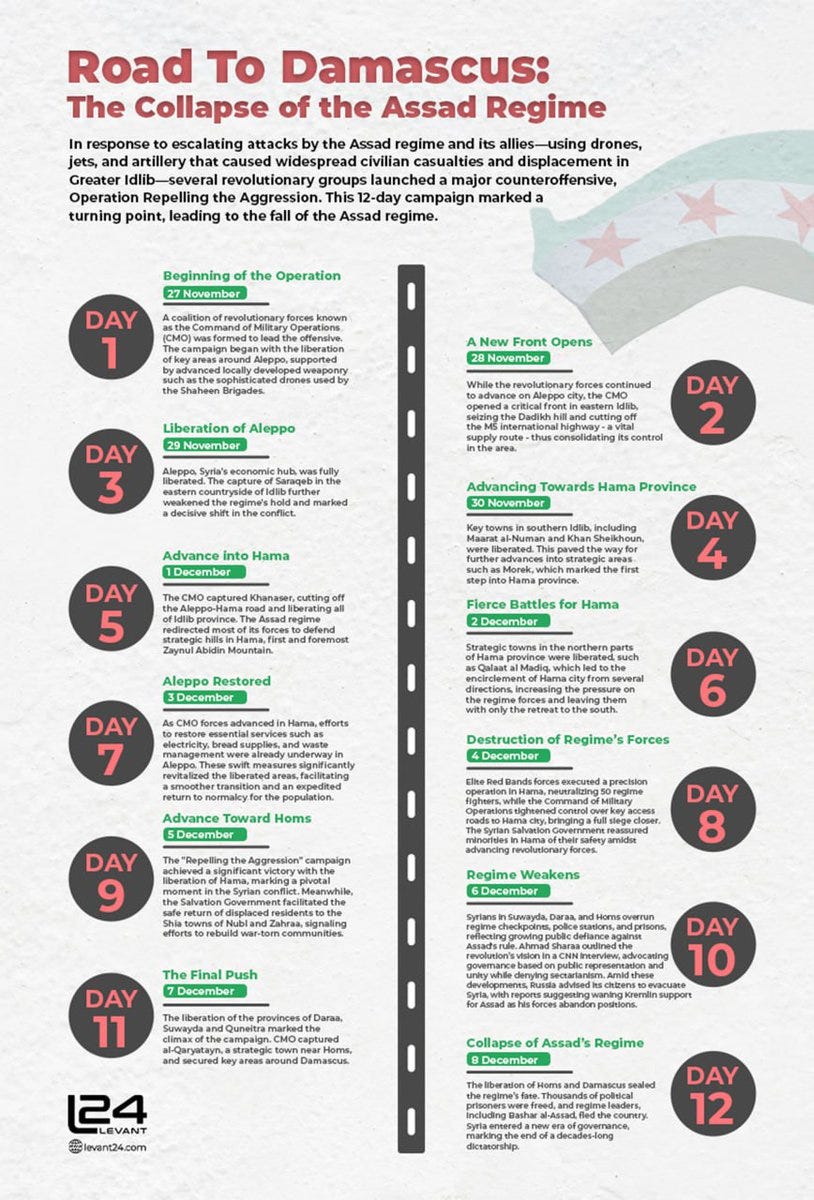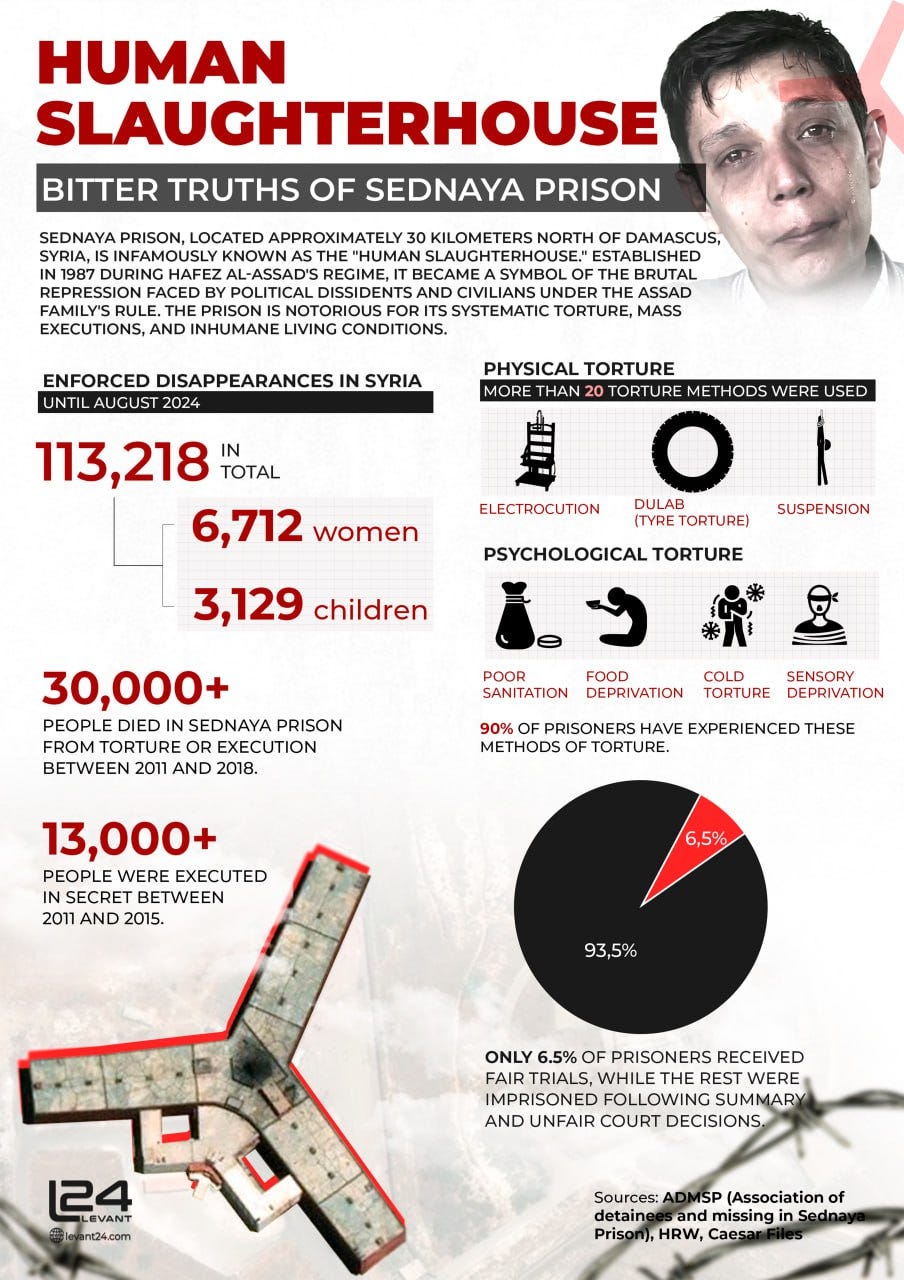Syria Weekly Report #1
A weekly roundup of the latest political, economic, and social developments in Syria, week commencing 9/12/24.
The Context Behind the Fall of the Assad Regime
Decades have happened in weeks. A revolutionary offensive in western Aleppo’s countryside beginning in late November snowballed into the capture of Aleppo city on November 29th, Hama city on December 5th, and the fall of the regime in Damascus on December 8th. By December 10th, the transition between the old regime and the new government commenced. Thirteen years of war ended in eleven days, and it has now been one week since the liberation of Syria from fifty-four years of rule by the Al-Assad family.
Hayat Tahrir Al-Sham (“HTS”), once Jabhat Al-Nusra, is led by Abu Muhammad Al-Jolani, now going by his real name, Ahmad Al-Shar’a. A designated terrorist organisation owing to past affiliations with ISIS and Al-Qaeda, HTS planned and led the revolutionary offensive which toppled the Assad regime in under two weeks. Perhaps the worst named campaign in modern military history, Operation ‘Repelling Aggression’ became a blitz of the entire country.
Why this offensive succeeded is largely owed to HTS’ proto-state development efforts in Idlib, and a perfect geopolitical storm in which the Assad regime was left without its two primary backers: Iran and Russia.
The Perfect Geopolitical Storm
Iran’s involvement in Syria dates to 2013 when the Assad regime was at risk of collapsing as rebel forces sprouted up across the country had captured most of the country since 2011. Iran brought in the Iranian Revolutionary Guard Corp (“IRGC”) and Hezbollah from Lebanon to shore up Assad’s increasingly nonexistent ‘Syrian Arab Army’ (“SAA”) which would be henceforth a patchwork of warlords and militias shored up by Iranian funding and Shi’ite militants from all over the region. What was left of the SAA was a severely demoralised and corrupt husk defined by forced conscription and humiliation.
However, even Iranian backing was not enough. In 2015, Russia had to get involved. With overwhelming airpower and the massacre of tens of thousands of Syrians through indiscriminate aerial bombing across the country, Russia helped Iran and Assad to turn the tide and eventually put east Aleppo city, one of the last urban holdouts of the Revolution, under siege. In late 2016, Aleppo city was captured by the Assad regime and their allies, dealing a massive blow to the Revolution.
Since then, various armed factions saw a massive rollback of their territory until the Revolution was confined to pockets of territory in Idlib, North Aleppo, and north-eastern Syria. Iran and Russia kept forces in Syria but slowly pared back their involvement as there was a feeling that the Assad regime was increasingly secure. In 2022, Russia invaded Ukraine hoping to take Kiev within a few weeks. It has now been nearly three years and Russia has been trapped in deeply attritional trench warfare in eastern Ukraine, consuming its armed forces, economy, and attention.
Iran’s “axis” of militias across the Middle East have been decimated by Israeli airstrikes, including Hamas, Hezbollah, the Houthis, and the IRGC themselves. Hezbollah’s senior leadership has been steadily wiped out since September 2024, when Hassan Nasrallah, the man who led Hezbollah’s charge into Syria, was killed in an Israeli airstrike in Beirut. Israel has also decimated axis supply-lines running through Iraq and Syria to Lebanon. The chains of command and resources that bound Iran’s “axis of resistance” have been broken.
Assad now had no allies left in Syria, and that meant no military force. Even if the Russians and Iranians wanted to respond and shore up the regime, facing their own geopolitical quagmires made it impossible to respond to the speed with which revolutionary forces were advancing and seizing cities.
Proto-State Development in Idlib
The speed with which HTS has positioned itself as the guardian of Syria’s transition process and state-building efforts shows years of planning and organisation for this moment. How HTS seeks to govern Syria will depend heavily on the culture and institutions that they cultivated in Idlib and how far they can be scaled. Since 2017, HTS has engaged in negotiation and conflict with other rebel groups cornered in Idlib to create a unified chain of command as a prerequisite to this path of proto-state development. This included purging remnants of ISIS and Al-Qaeda, groups that HTS and its leader, Al-Shar’a, had previously been affiliated with. By 2020, this process of consolidation was largely complete. HTS has pursued the enforcement military consolidation and the adoption of modern doctrine, including the creation of the ‘Military College’ to produce something like a professional officer class, the division of their army into specialised units, and the largely autonomous production of small arms, artillery, and drones.
Alongside its military efforts, HTS also developed civilian governance under the ‘Syria Salvation Government’ (“SSG”), starting with departments and additional government services ranging through ID issuance, tax collection, and public transport. Other civilian bodies like the White Helmets (officially the Syrian Civil Defense) were successfully incubated in Idlib and are now conducting operations all over Syria, ranging through de-mining operations (which has already cost lives), emergency response, and as search and rescue teams at Sednaya prison. If money is the lifeblood of armies, HTS seems to have well understood the need to generate revenue to support its operations. They have promoted and incentivised private enterprise that could then provide tax revenue to the SSG, and by extension, HTS. Taxation has been streamlined, with the sort of crony corruption that happened in Assadistan largely purged. They have even promoted private competition against their own “state-backed” companies e.g. in Telecoms.
This experience proved invaluable as HTS and allied forces blitzed through Aleppo province, and finally the main city itself. Within a week, control of civilian areas were handed over to civilian institutions, i.e. the SSG, and military forces continued to march forward towards Hama and other areas. Scaling these institutions has proven a difficult task, with what was once a a territory covering half of Idlib now responsible for the governance of all of Syria west of the Euphrates.
A New Government in Damascus
Part of scaling these institutions will be acquiring the legitimacy to do so in the first instance. HTS, through the SSG, is now seeking to fold itself into the Syrian state. After Damascus was secured by revolutionary forces from the south and north on December 8th, a transition government was announced by HTS on December 9th, appointing former head of the SSG Muhammad Al-Bashir as interim Prime Minister with a new technocratic cabinet. On December 10th, a formal handover of power occurred between former Prime Minister Muhammad Ghazi Al-Jalali of the Assad regime and Al-Bashir.
HTS has stated that this government will persist until at least March, with Al-Shar’a confirming that there will be a panel of experts and lawyers to examine and propose a new constitution for the Syrian state.
Al-Shar’a has also confirmed that elections will occur in Syria, although it is not yet clear when this will occur and what form it will take. It is highly likely that Al-Shar’a himself will run in elections, although it is too early to tell whether Syria will maintain a Presidential system, shift to a Parliamentary system, or seek something else entirely.
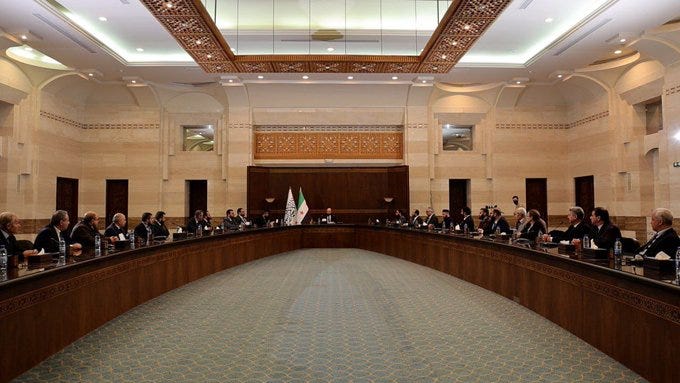
The task of the new government is monumental. Functionally, there is no “state” in Syria, just ties to the Assad family and his henchmen. With most of them having fled, dead, or in hiding, what remains of the Syrian state exists only on paper and much of it will have to be built from scratch.
Timour Azhari’s interview with the new interim Governor of Damascus, Mohammed Ghazal, a UAE-educated civil engineer from Syria who has also worked in the SSG in Idlib, provides more colour on the problems facing the interim government’s attempt to revive what is left of the Syrian state, which Ghazal describes poignantly as ‘ruins, ruins, ruins.’
If the government can successfully scale the sort of services it provided in Idlib to the rest of the country, that alone would see a massive improvement in the quality of life for Syria’s war-and-poverty ravaged population. Much of the government’s focus will be on low-hanging fruit like streamlining laws and regulations and introducing digitisation. New mobile applications are being launched to provide government services to residents across Syria. There is already an application for those with missing loved ones (having been abducted by the Assad regime) can submit details for the relevant department to investigate. Bus lines are being set up for inter-city and cross-country travel, something that has not existed in Syria for the past decade. These are relatively small but sure attempts at restoring normal services.
Syria’s Economy
A key detail here is that in Idlib, the minimum salary for SSG employees is $100 a month. Under the Assad regime, government employees were nominally paid a baseline salary of $25 a month, though were often not paid in any case owing to endemic corruption and dysfunction. The government has stated that it will bring all employees’ salaries up to a baseline of $100. This is a 400% increase that could be made possibly simply by the efficiency gains that would come from eliminating Assad regime cronyism, streamlining taxation, and encouraging private enterprise. The government has already stated their plans to ‘adopt a free-market model and integrate the country into the global economy,’ which would open up Syria’s economy for the first time in over fifty years. Syria’s currency has strengthened since the fall of the Assad regime, and Al-Shar’a has declared plans to introduce a new currency in the near future. This is a positive turnaround from the pseudo-socialist turned narco-state model that the Assad regime operated in Syria.
The sheer mismanagement of Syria under the Assad regime is perhaps no more evidenced than the comparison in the superior standards of living in Idlib under SSG governance. Food, water, electricity, cellular networks, internet, foreign goods, and streamlined governmental services are all available and operate as reasonably well as they could have done in war-time Idlib. In Assadistan, electricity was available for a few hours a day, foreign goods were impossible to find, and the population was increasingly starved as bread queues would extend for hours on end. Bear in mind, pre-war Idlib was treated as the equivalent of Syria’s “Appalachia”, a poor and rugged countryside with people to fit. Today, Idlib is likely the most prosperous province in Syria.
It is estimated that the Assad family controls around $16 billion in assets, which is nearly double Syria’s estimated GDP of $9 billion. The Assad regime did not just pillage Syria; they raped the country. To add insult to injury, they turned the country into a de facto narco-state with the production and distribution of Captagon pills that have ravaged the streets of the wider Middle East, earning the regime billions of dollars in income and even more sanctions whose brunt was born by the Syrian people.
Lessons Learned?
The meticulous planning and execution of HTS’ move into power shows not just remarkable institutional flexibility, but a willingness to learn from mistakes that have been committed across the region. They have made a point of pursuing a gradual “de-Baathification” process in Syria as opposed to the disastrous process pursued by America in Iraq in 2003. The handover of the Syrian government from ex-PM Al-Jalali over to the interim PM Al-Bashir shows the desire for a gradual replacement of what remains of the Syrian state. Government employees under the Assad regime have been told to report for duty in the new government. Some members of the last Assad regime cabinet have stayed on in the new cabinet to help manage the transition.
Additionally, Al-Shar’a has been holding numerous meetings as part of a strenuous effort at coalition-building across various sections of Syrian society. Coalition building also extends outside the country: Walid Joumblatt, a Druze politician in Lebanon, made a phone call to Al-Shar’a and expressed his desire to come to Damascus.
The greatest misstep HTS would make now is to try and assume total ownership of and power over Syria without consultation or power-sharing. The fall of Muhammad Morsi and the Muslim Brotherhood in Egypt in 2013 was partially owed to their failure to build a cross-societal coalition in Egypt, leading to support for a military coup under Abdel Fattah Al-Sisi. It seems that Al-Shar’a has paid attention to these events and wants to ensure that there is no opportunity for a counter-revolution.
The coordination between HTS in the north and southern factions in Daraa also suggest a desire to prevent Syria from falling into a Libya scenario after the fall and execution of Muammar Gaddafi. Al-Shar’a was able to enter Damascus with his HTS forces after it was taken mainly by southern factions and ensure a smooth handover. HTS has clearly been accepted as the military Primus Inter Pares in Syria among all the opposition forces, something that for now maintains the peace between these various armed factions.
HTS is likely to be dissolved at some point in the near future and become part of the new Syrian military. Military conscription will be removed, hinting at further professionalisation of a new Syrian army that will likely see closer ties with the Turkish military, whose government has offered support in areas such as equipment and training. Al-Shar’a himself has dropped military uniform for civilian garb, suggesting that the objective is to subordinate military structures entirely to civilian institutional authority.
Islamic Governance or Governance by Muslims?
Throughout this, the main question now on everyone’s mind will be the role that Islam as a religion will have to play in the new state. One indicator of how Al-Shar’a sees Islam in the new Syrian state is that the first Friday prayer sermon in liberated Damascus was held by the interim PM Al-Bashir himself. This is a common signal of legitimacy and authority in the Sunni Islamic political tradition, and the future Syrian state will likely be closely associated with the Sunni majority of the country.
In the above interview with Mohammad Ghazal, he states quite flippantly that, ‘there is no such thing as Islamic governance.’ HTS seem to be running an experiment in creating a new type of 21st-century ‘theory of statecraft’ from the Islamic perspective which rejects the 20th century impulse of ideology and slogans to “Islamise” things in form even if it corrupts the substance. ‘Personnel is policy’, and the government seems intent on proving that the substance of governance takes precedence over its form.
There is also a great deal of pragmatism being shown as HTS knows that diplomatic relations and the lifting of sanctions which are necessary for the redevelopment of the country will hinge heavily on how Syria is perceived, and care is being taken to avoid comparisons to countries like Iran and Afghanistan.
Various statements made by the interim government indicate that they are keen to avoid the mistakes made in countries like Saudi Arabia, Iran, and Afghanistan. In a 2022 interview on the topic of hisba (a market and ‘good conduct’ inspector), Al-Shar’a stated that the form of hisba adopted in other Muslim countries was a poor approach because the public enforcement of religion breeds hypocrisy.
Foreign Affairs
On the foreign affairs front, HTS’ Political Affairs Department is the only party meeting with foreign officials, including ambassadors from nearly all Arab and Middle Eastern governments, and maintaining backchannels with several European governments and the USA. HTS also helped get an American imprisoned by the Assad regime out of Syria and back to the USA, with no strings attached, signalling their intentions towards the US government. Bahrain as current head of the Arab League has sent a statement of support, and a French mission is visiting Damascus on Tuesday. The UK has also been ahead of the curve, confirming diplomatic contact with HTS.
Calls for the lifting of sanctions on Syria are gaining steam, conditioned on Syria’s stable transition to a democratic system. Although it seems apparent that the world is tired of Syria, not least those who have seen massive Syrian refugee in-flows causing political and social cleavages. If removing sanctions can happen sooner rather than later to get Syria going, most countries are likely to start doing so.
All this occurred against the backdrop of regional and international powers easing Bashar Al-Assad back into the international system, and the sudden collapse of his regime has turned these efforts on their head. International conferences in Doha and Amman saw meetings between state ministers from various countries scrambling to understand and respond to these events.
There is fear in countries like Jordan, Iraq, and Egypt that events in Syria may inspire their own people. For the past decade, the repression of the Arab Spring was in large part justified by the bogeyman scare of, ‘Do you want our country to turn into Syria?’ As the fundamental issues that spurred Arabs to the streets in the Arab Spring remain unsolved if not worse in many cases, such as increasing economic dysfunction, injustice, and authoritarian repression, the Arab street might just starting saying, ‘Yes.’
The persistent threat of ISIS elements who still remain in the eastern deserts of Syria. With an ISIS franchise operating in numerous countries across Africa, the Middle East, and central Asia, there is an opportunity for the new Syrian state to establish intelligence links dedicated to combating ISIS. The assassination of a senior Afghani government minister last week by an ISIS member shows the necessity of more collective state-level efforts to achieve this.
Perhaps the biggest question is the Israel problem. Al-Shar’a has stated that war with Israel is not on the cards. Considering the leeway that the West, in particular the USA, has given to Israel to conduct a campaign of extermination in Gaza, allowing Israel to bait Syria into conflict would be a disaster. The weakened state of the Syrian people requires a path of quiet development as the only thing that can be done in the face of Israeli aggression, which includes the de facto annexation of further Syrian territory in the Golan Heights and hundreds of bombing raids. If the new Syrian state develops enough international legitimacy, Israel’s brazen aggression may yet come to backfire on it. The last thing Israel wants is a stable, respected, and democratic power on its borders.
Domestic Affairs
The country is not yet unified under one military authority even if the government in Damascus has at this point been nominally accepted by all military factions in the country. There is a lack of manpower and general chaos caused by the sudden collapse of the Assad regime, and much of the countryside and country’s borders remain poorly or entirely unmanned by civilian or military personnel. There are reports of ambushes occurring against revolutionary forces in Latakia, where there is a strong Alawite presence in the hillside villages. Many members of the Assad regime, members of the Alawite communities of Latakia and also where the Assad family hail from, have retreated to these villages. The Syrian border remains porous, ranging from fairly secure with Türkiye to a complete absence of control with Lebanon.
There are still four distinct military factions operating in Syria:
In white: Hay’at Tahrir Al-Sham (“HTS”), which controls Syria’s main cities west of the Euphrates;
In light green: the Syrian National Army (“SNA”), a Turkish-backed, equipped, and coordinated faction operating in pockets across northern Syria;
In purple and dark green: Southern Forces (“SF”), a coalition of groups in Daraa and Suweyda provinces with one of the main forces headquartered in Daraa and led by Ahmad Al-Awda, also known as ‘the Chameleon’ owing to his repeated switching of allegiances throughout the war. Al-Awda is a wild card who is likely in reserve as Syria’s “Heftar candidate”;
In yellow: The Syrian Democratic Forces (“SDF”, “YPG”, “PKK”, etc), based in north-eastern Syria where the PKK has attempted to carve a statelet for itself called “Rojava”.
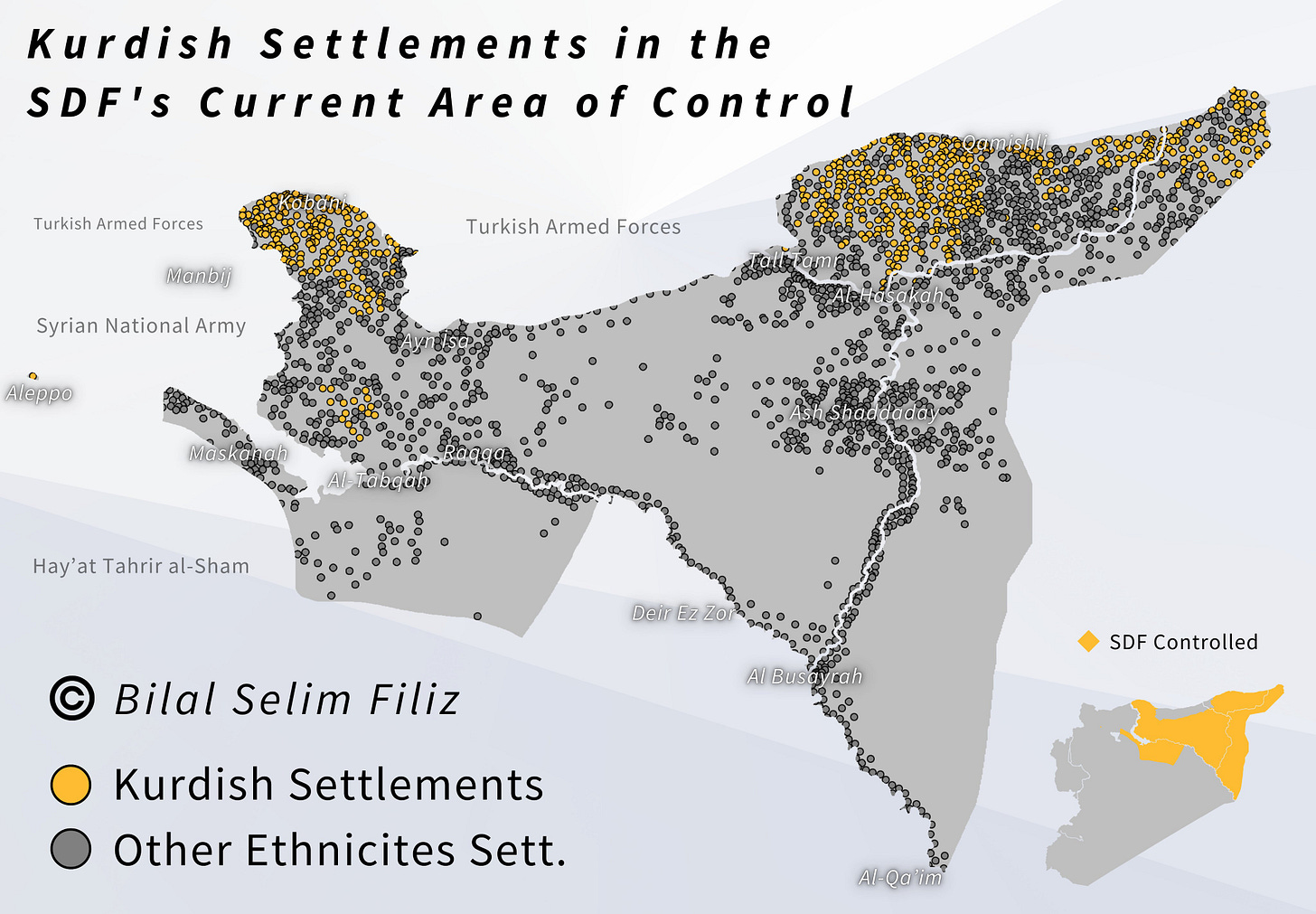
The Future of Kurds in Syria
The PKK present a distinct problem in Syria. Their raison d’etre was to protect Kurdish-majority regions and fight ISIS. Now the PKK mostly rule over Arab tribes who are deeply resentful of them, and there is an actual government in Damascus has both experience and intent to deal with ISIS itself. While Russian forces are preparing for what is likely to be a full withdrawal from Syria, American troops are being directed to dig in alongside PKK forces in defiance of Turkish demands for the complete dismantling of PKK forces in Syria. Yet, Donald Trump will ascend to the US Presidency in January and has repeated signalled his desire to pull all US troops out of Syria. He will be hard to convince that there is any reason to keep them longer if he can come to an agreement with the government to take on the fight against ISIS.
As for the government, Al-Shar’a has opted not to come into conflict with either side, instead acting almost as a mediator. The PKK has raised the Syrian national flag on buildings across its territory to try and signal compromise, and under the umbrella of the “SDF” have stated that they have no problems with the government in Damascus. Rumours of deals are flying but there has been nothing official thus far. Al-Shar’a has stated that he wants the Kurds to participate in the building of a new Syria, and offered help to the Kurds who were expelled from their homes in Afrin in the 2018 offensive led by the SNA. Al-Shar’a has made a point of separating the PKK from the Kurdish people. What all this actually looks like in practice is still unknown or being kept quiet for now.
Civilian protests pushed the PKK out of the west bank of Deir Ezzour province, and protests are ongoing in Raqqa, too. Scenes of civilian massacres have done little to earn the PKK claims to legitimate governance over north-eastern Syria. The PKK also stands accused of killing dozens of civilians over the past month in Aleppo city where they maintained a holdout in the Kurdish-majority district of Sheikh Maqsud. Syrians have not forgotten how the PKK helped the Assad regime to put Aleppo city under siege and eventually defeat the then-opposition in 2016.
It seems that the Rojava adventure is likely to meet its end in the coming months and is unlikely to be missed except in Green Party headquarters across Europe and perhaps Washington D.C.
A Charm Offensive with Syria’s Minorities
HTS has also been on a charm offensive with Syria’s minorities, sending representatives to the Druze, Christians, Ismailis, and Alawites to assure them of their rights and, especially to the Alawite community, that they do not seek ‘vengeance’. Thus far, no actual sectarian violence has been reported.
There is a cautious optimism being expressed in articles and videos, with numerous join marches across cities in Syria to celebrate the overthrow of the regime. It remains likely that most minority communities are waiting to see how events unfold in the coming months — and what Syria’s new constitution will eventually look like.
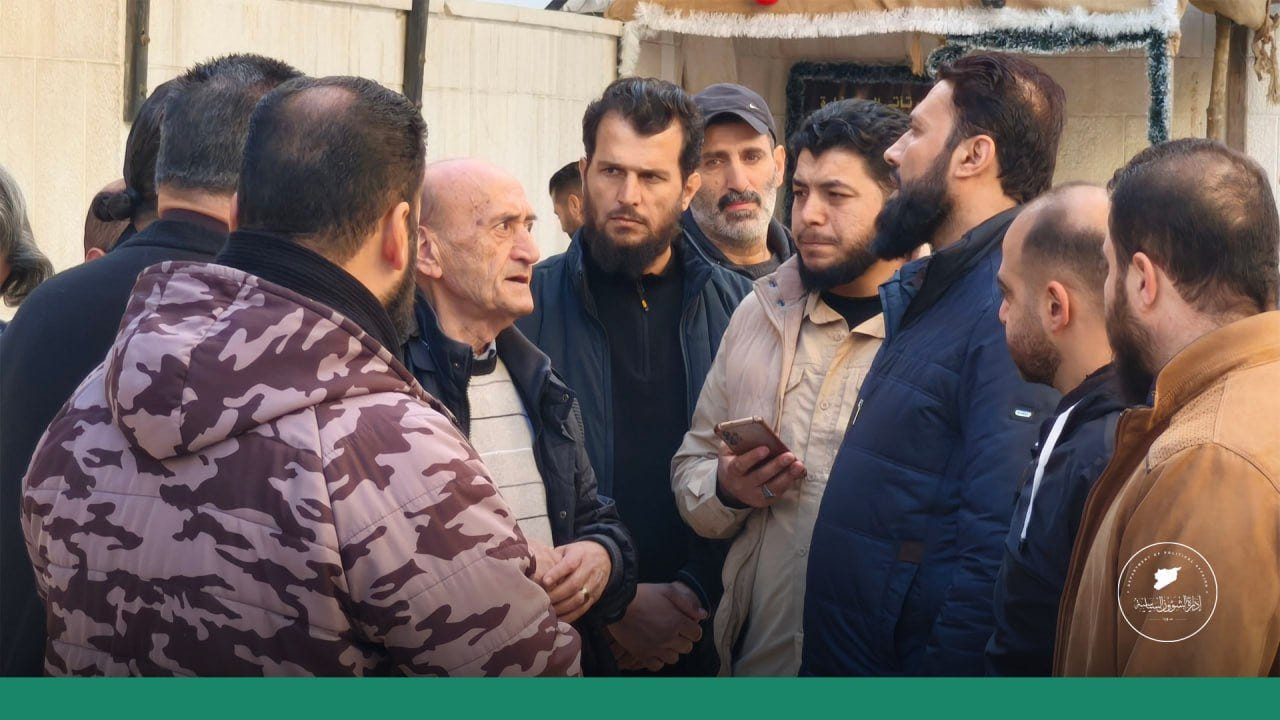
Reconstruction, Reconciliation, Redevelopment
It has been a week since the fall of the Assad regime, and the process of scaling up civilian institutions, establishing military security, and restoring some semblance of the Syrian state will take several years. The primary objective of the new state is going to be reconstruction and the return of refugees. Millions of Syrians remain in exile and they will need homes and services to return to. Tens of thousands of families also remain bereft of closure with regards to the fate of up to 100,000 prisoners of the Assad regime whose bodies have not been found. And all of this will require the restoration of economic activity.
These are Syria’s most dangerous moments in the past thirteen years, a ‘honeymoon period’ as cities across the country see massive rallies celebrating the fall of the regime. People have high hopes, and with that comes the potential for great betrayal. As life settles and the Syrian people begin to have a feel for their newfound rights, more demands will come on the government to provide adequate services and for a more structured roadmap that leads to a new constitution.
There is also a decent risk of low level conflict occurring in the coming months as former revolutionaries do not take well to the rigours of state-building. Al-Shar’a has stated that Syria must now transition from a revolutionary mentality to a state-building mentality. Whether the coalitions he has built, and those he continues to try and build hold throughout this process is unknown.
By summer 2025, the future path for Syria will be much more clear. It is our hope that the basic trappings of a modern state will have come into existence, security will exist in most parts of the country, and the government will be able to coordinate the development of Syria’s economy. This will depend on state-building efforts already well underway, and as with any state, most of what defines it comes in its initial founding moment. And this era is precisely the (re)founding of a new nation.
After Italy’s unification in 1870, the Prime Minister Massimo D’Azzeglio quipped, ‘We have made Italy, now we must make Italians.’ Syrians may take affront to this, but it rings equally true for Syria. She is a country where division and distrust has been bred into every aspect of her social fabric, and it will require immense social engineering to both undo this division and create a new identity that does not leave Syria as a dysfunctional, sectarian maze. Bribery was a part of everyday life, ranging from passing checkpoints to cross from one area to another to getting out of military conscription. Creating a culture where bribery is not expected or accepted will be difficult. ‘Tashbeeh’, the excessive glorification of the leader, is another issue that those now in power in Syria must be careful not to encourage if not seek to eliminate outright.
If Syria is to be a democracy, the greatest danger the country faces is to become a scaled-up Lebanon. A democracy for democracy’s sake would turn into a de facto confessional state stymied by tribal division at every turn: urban vs rural, religious, ethnic, etc. Parties will form on identitarian lines, and everyone will be focused on using the state as a vehicle for extraction favouring their own tribe. Insofar as Syria is to be a democracy, the ideal is some form of technocracy focused on giving all citizens a voice in policymaking. Democracy for democracy’s sake is a cult; democracy is a tool to be used among many other tools acting as feedback mechanisms to enhance the effectiveness of state to provide all of its citizens with liberty, prosperity, and security.
Another danger that faces Syria is its disastrous economic situation. Heavy sanctions still remain on Syria from the Assad regime era, and western states are now using these sanctions to try and influence the course of events in Syria. In any case, the worst scenario is for Syria to become permanently dependent on aid. For now, aid is necessary to get the people of Syria the basics that they need to survive. However, when the issue of sanctions and a new government and constitution are resolved, the fundamental stance of that government should be to reject aid and permit only investment in productive enterprise, giving Syrians economic opportunity and freedom. There is no cultural barrier here: Syria has long been an urban trading culture. They only require rule of law, property rights, and access to the global supply chain to prosper.
If the new government is what it says it wants to do, then we have every reason to dare to dream.
Link Dump
While the world busied itself with the normalisation of the Assad regime, his forces were increasingly hollowed out and ineffective, leading to their sudden collapse against revolutionary forces.
‘Their bodies had turned to black’
Calls for a re-investigation into numerous chemical attacks carried out by the Assad regime.
Tangled Tale of the Fugitive Nazi and the Syrian Secret Service
The story of the Nazi fugitive Alois Brunner’s tenure in Syria under the Assads, and his contribution to the construction of Syria’s prison state.
Syrians face grim prospect of never finding missing relatives
Most missing persons who have been abducted under the Assad regime, numbering up to 100,000, are most likely dead.
Families Seek Closure at a Damascus Morgue
While many celebrate the overthrow of the Assad regime, tens of thousands of Syrians are desperately searching for loved ones — dead or alive — abducted by regime forces into their torture dungeons.
A writer from the Israeli-occupied Syrian Golan Heights recounts the stories of the many Syrians imprisoned by Israel, who are now politically “orphaned” and neglected by history.
In 1967, Israel occupied the Golan Heights from Syria and ethnically cleansed 95% of the Syrian Arab population.
Infographics
Levant24, an independent Syrian media organization has produced some excellent infographics:




